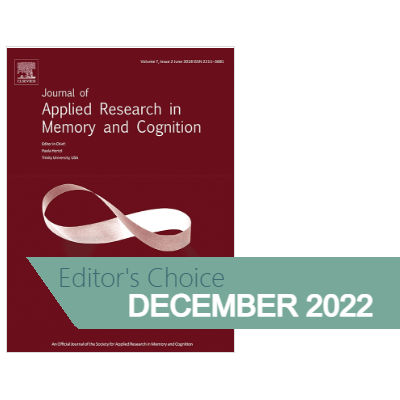JARMAC Editor's Choice: December 2022
/Memory sins in applied settings: What kind of progress?
AUTHORS: DANIEL L. SCHACTER
Over two decades ago, Schacter proposed that memory errors could be classified into seven basic categories or sins, including three “sins of omission” that refer to different kinds of forgetting and four “sins of commission” that refer to cases in which memory is present but either wrong or unwanted. In this article, the author discusses research conducted during the past 2 decades that has examined several of the memory sins in everyday settings. They conclude that we have made impressive progress in understanding how memory sins impact our function in everyday settings and generating steps to counter them, identify gaps in our knowledge and future research directions, and discuss implications for our understanding of the reliability of human memory.
Fair lineups improve outside observers’ discriminability, not eyewitnesses’ discriminability: Evidence for differential filler-siphoning using empirical data and the WITNESS computer-simulation architecture.
AUTHORS: Andrew M. Smith, Laura Smalarz, Gary L. Wells, James M. Lampinen, Simona Mackovichova
Fair lineups lead to a better trade-off between guilty-suspect identifications and innocent-suspect identifications than biased lineups. Why are fair lineups better? Some researchers argue that fair lineups increase the ability of eyewitnesses to discriminate between the guilty and the innocent, whereas others argue that fair lineups simply spread identifications across fillers and that this filler-siphoning process is more pronounced when the suspect is innocent than when the suspect is guilty (differential filler siphoning). In Experiment 1, fair lineups led to fewer guilty-suspect identifications and a similar rate of correct rejections compared to biased lineups, which is inconsistent with the improved discriminability account. In Experiment 2, computational modelling demonstrated that a spreading effect (differential filler-siphoning) produced a fair-lineup advantage even when the psychology of simulated witnesses was held constant across fair and biased lineups. Together, these findings support differential filler-siphoning and the idea that fair lineups enhance outside observers' discriminability, not eyewitnesses' discriminability.
A new method to implant false autobiographical memories: Blind implantation.
AUTHORS: Henry Otgaar, Georgiana Moldoveanu, Victorien Melis, Mark L. Howe
In this article, the authors offer an elegant new paradigm to implant false autobiographical memories. Participants received a list of 20 autobiographical events including a critical false event (i.e., swimsuit falling off) and indicated whether they had experienced these events. After 1 week, participants who had not experienced the false event received a second survey suggesting that they had experienced the false event either once (Single group) or repeatedly (Repeated group). Participants provided belief and recollection ratings and event-related details. Depending on memory type, false memory implantation ranged from 9% (for false memories) to 30% (for detailed false reports). Furthermore, false beliefs were most likely to be elicited in the Single group. This novel paradigm can offer new insights on how false autobiographical memories can be implanted.


